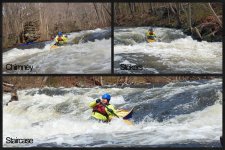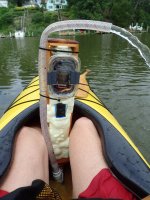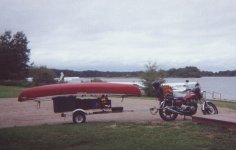I was back with the kayakers yesterday to paddle a short, fun river in north central CT – the Scantic. The Scantic arises near Springfield, MA and flows southwest into CT to join the Connecticut River. We would be running the 5-mile section from Somers to Hazardville that is the site of the annual Scantic Spring Splash downriver race.
With all the rain this week the river was at a nice level - Jo-Ann described it as “sporty”. We had 9 boats – 8 kayaks and 1 canoe – what else is new. There are 4 class II+ (maybe class III at this level) rapids - Trestle, Stokers, Chimney and Staircase.

I made it through all the rapids fine, but filled up my boat running the bottom drop at Chimney. I pulled into the eddy, but I didn’t have my bailer and there wasn’t anyplace to get out to empty my boat, so I pulled back out into the current to find a place downstream. Unfortunately, with a boat full of water I flipped in the small drop – second swim of the year for me.
Every time this happens, I think it is time to put in an electric bilge pump. Then I think of the weight, the work of putting it in, and how many times I’ll actually need it. If I was paddling bigger water or long rapids it would be one thing, but maybe I should just remember to bring my bailer.
Has anyone around here sprung for a pump? How often do you actually put it in the boat?
Few more pictures here:

With all the rain this week the river was at a nice level - Jo-Ann described it as “sporty”. We had 9 boats – 8 kayaks and 1 canoe – what else is new. There are 4 class II+ (maybe class III at this level) rapids - Trestle, Stokers, Chimney and Staircase.

I made it through all the rapids fine, but filled up my boat running the bottom drop at Chimney. I pulled into the eddy, but I didn’t have my bailer and there wasn’t anyplace to get out to empty my boat, so I pulled back out into the current to find a place downstream. Unfortunately, with a boat full of water I flipped in the small drop – second swim of the year for me.
Every time this happens, I think it is time to put in an electric bilge pump. Then I think of the weight, the work of putting it in, and how many times I’ll actually need it. If I was paddling bigger water or long rapids it would be one thing, but maybe I should just remember to bring my bailer.
Has anyone around here sprung for a pump? How often do you actually put it in the boat?
Few more pictures here:



